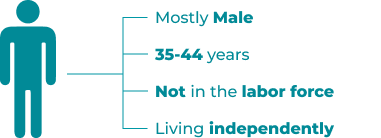Outpatient Treatment Stats 2024
Outpatient treatment is a continuous need in New Jersey. The most readily available data from the New Jersey Department of Human Services (2021-22)1 and the 2023-24 New Jersey Substance Abuse Monitoring System (NJSAMS)2 results explore the basis of addiction trends in the state.
This information on outpatient treatment provides an accessible overview of the recovery space.
Key Findings on Outpatient Treatment in 2024
Regarding traditional outpatient admissions, July 2023 until March 2024 show 20.9% admissions, while 2022 data highlights 19%. In 2023-24, New Jersey faced a formidable challenge in substance abuse. This includes 55,691 total treatment admissions and 54,635 discharges. It’s clear there’s a need for adequate care and prevention measures.
A Brief Overview:
Primary Substances Involved:
Alcohol
22,547 admissions, 40.5%
Heroin
17,285 admissions, 31%
Other opiates
3,966 admissions, 7.1%
Cocaine/crack
4,767 admissions, 8.6%
Marijuana
3,624 admissions, 6.5%
Other drugs
3,370 admissions, 6.1%
Demographic Insights:
Most individuals seeking treatment were male (38,950 admissions, 69.9%). There’s representation across various age groups, particularly those aged 35-44 years (29.7%). A substantial number of individuals were not in the labor force (27,322 admissions, 49.1%). The majority were living independently (37,383 admissions, 67.1%).
Geographic Distribution:
Most admissions were in counties like Essex (5,282 admissions, 9.5%) and Atlantic (4,965 admissions, 8.9%).


Effectiveness of Treatment Approaches
Outpatient treatment includes various evidence-based therapies. These aim to address mental health and substance use disorders (SUDs). Most programs, like The Hope Institute’s, leverage traditional and innovative practices’ merits.
Traditional Therapies:
Cognitive-Behavioral Therapy (CBT) and Dialectical Behavior Therapy (DBT) are widely used. These target negative thought patterns and behaviors. Individuals learn to adopt healthy habits to avoid these patterns.
Newer Techniques:
Mindfulness-based interventions (MBIs) are increasingly effective. Practices like meditation and yoga help reduce anxiety and improve general well-being.

In 2023-24, the majority of those in treatment (64.7%) stopped using alcohol/drugs completely by discharge.3 Additionally, the main reason for discharge was completing a treatment plan (53.1%). This amplifies the success of proven techniques and the relevance of newer practices in outpatient care.
In the 2022 dataset, there is further information on specific population groups. For instance:
- Child Protection/Child Welfare Program: 3,442 (4%)
- Driving Under the Influence: 9,162 (11%)
- Early Intervention: 278
- Interim Services: 19
- Developmental Disability: 271
- Blind and Visually Impaired: 149
- Deaf and Hard of Hearing: 143
This indicates a smaller prevalence when it comes to individuals with special circumstances. However, it also shows the need for curated treatment programs that consider special needs.

Access and Availability
While outpatient treatment offers many benefits, access can be challenging for some. In the 2023-24 NJSAMS results, there were the following disparities for discharges:
Gender:
38,053 male (69.6%) and 16,531 female (30.3%)
Race/Ethnicity:
Mostly White (57.4%), followed by Black (25.9%), Hispanic (15.7%), and other (1.4%)
Age Group:
35-44 years (30%) was the largest, followed by 45-54 years (18.9%), and 55+ (17.1%)
Factors like income, insurance, and location can create disparities in access to outpatient care. Additionally, treatment capacity can also create an issue. To ensure shorter wait times, streamlining processes could be helpful. This includes telehealth alternatives for certain process components, like admissions.
Breakdown of Outpatient
Treatment Utilization by Condition
Outpatient treatment can help with mental health and addiction-influenced chronic disorders. At The Hope Institute, for instance, we treat a variety of substances and dual-diagnosis conditions.
Trends in Outpatient Treatment Costs
The cost of outpatient treatment can be a make-or-break factor for those seeking care.
Cost Drivers and Cost-Saving Strategies
- Insurance Coverage: High deductibles can impact affordability. In 2023-24, the majority (71.1%) of admitted clients had Medicaid upon admission. Private insurance (17.5%) came in second with drastically fewer clients.
- Out-of-Pocket Expenses: Financial assistance programs can improve access to care. This is crucial since, in 2023-24, 12.7% of clients had no insurance at the admission stage.
- Cost-Effective Models: Innovative delivery models, like virtual care, can help reduce overall costs.
Financial Sustainability of Outpatient Treatment
Because of the need for outpatient services, payment options must be viable and sustainable. Some potential solutions include:
- Government Funding: State-subsidized and public-private partnerships can improve access. This helps ensure more individuals receive the care they need.
- Addressing Cost Increases: If new practices add costs, payment plans should be in place. Moreover, the 49.1% of individuals out of the labor force highlights a socioeconomic hurdle to outpatient programs.
The Impact of Telehealth on Outpatient Treatment
Telehealth revolutionizes accessibility in outpatient treatment. This is because of its impact on costs and reach.

Benefits and Challenges of Telehealth Delivery
- Improved Access: Individuals in remote areas can still receive online outpatient care. Telehealth services also benefit those with limited transport.
- Convenience: Scheduling appointments can be more flexible. This allows individuals to take part from the comfort of their homes. It also facilitates more client freedom to maintain other life obligations.
Despite the huge step forward, telehealth services are not without concerns:
- Privacy and Security: Virtual outpatient treatment must protect sensitive patient data. Both clients and OP providers should ensure their devices are private and updated with security software.
- Technological Barriers: Not all clients have access to computers or reliable internet connections. This highlights an area to improve on in the telehealth space. This is especially true since 16.3% of those in treatment between 2023-24 were homeless.
Integration of Telehealth into Existing Outpatient Care Models
Since telehealth and traditional care have ups and downs, it’s best to combine them. This promotes flexibility and strengthens the quality of care. Blended care can improve patient-centered approaches in the following ways:
- Appointments & Therapy Sessions: Schedule initial consultations and solo therapy sessions with technology. For example, online consultation forms.
- Medication Management: For shorter sessions, like medication reviews, telehealth consultations can be used.
The Future of Outpatient Treatment
Beyond the telehealth space, there are technological advancements that could improve outpatient treatment.
A Guide to Non-Residential Addiction Treatment
Outpatient treatment programs offer a flexible approach to addiction recovery. They range from intensive options like Partial Hospitalization Programs (PHPs) to standard outpatient care.
What is an Outpatient Treatment Program?
Outpatient rehab programs provide addiction treatment services without requiring in-facility, overnight stays. Whether done in the daytime or virtually, clients still receive effective care.
Advantages of Outpatient Treatment Programs
Maintain work & family commitments
More cost-effective option compared to inpatient rehab
Can be used for long-term recovery support
Don’t require on-site facility stays
At-home support from loved ones
Access to local resources, like support groups
Disadvantages of Outpatient Treatment Programs
Requires strong self-discipline and motivation
Might not be suitable for severe addictions
Less structured than inpatient programs
Co-occurring mental health disorders may need more comprehensive care
Data Sources:
- New Jersey Department of Human Services
- New Jersey Substance Abuse Monitoring System (NJSAMS) [Dates in Dataset: Jul 1, 2023 - Mar 10, 2024; Report Type: Admissions]
- New Jersey Substance Abuse Monitoring System (NJSAMS) [Dates in Dataset: Jul 1, 2023 - Mar 10, 2024; Report Type: Discharge]
- Division of Mental Health and Addiction
- United Health Foundation. (Accessed: June 2024). Depression in New Jersey
- Boeldt, D., McMahon, E., et al. Using Virtual Reality Exposure Therapy to Enhance Treatment of Anxiety Disorders: Identifying Areas of Clinical Adoption and Potential Obstacles. Front Psychiatry. (2019)
